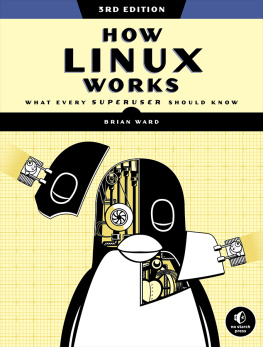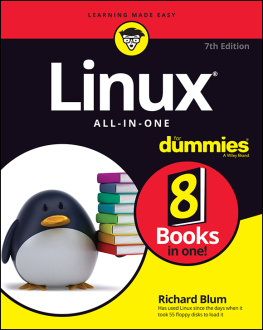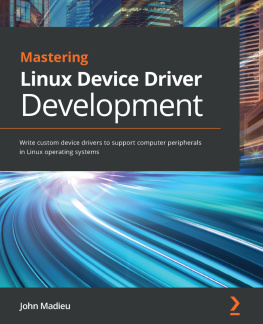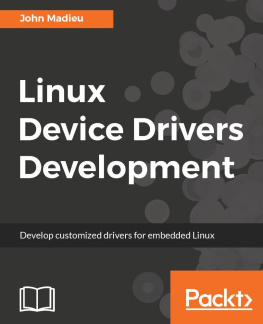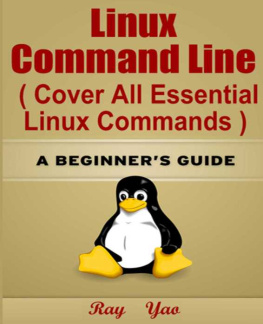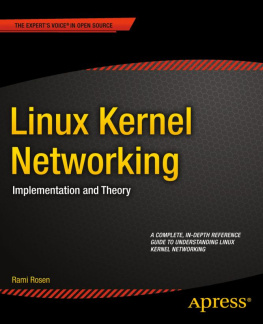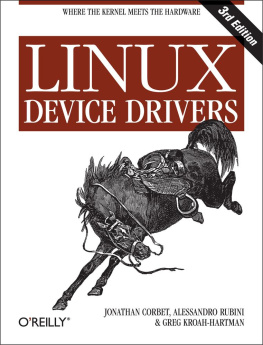Lots to offer on almost every aspect of the Linux architecture.
Youll get an essential understanding of whats going on under the hood without getting bogged down in minutiaemaking this a very refreshing (and wholly recommended) addition to the Linux literature.
Dives straight into the transparent depths of Linux-based operating systems and shows us how all the pieces fit together.
Earns its place on the shelf as an essential reference.

San Francisco
How Linux Works, 3rd Edition. Copyright 2021 by Brian Ward.
All rights reserved. No part of this work may be reproduced or transmitted in any form or by any means, electronic or mechanical, including photocopying, recording, or by any information storage or retrieval system, without the prior written permission of the copyright owner and the publisher.
Publisher: William Pollock
Executive Editor: Barbara Yien
Production Editor: Rachel Monaghan
Developmental Editors: Larry Wake and Jill Franklin
Cover and Interior Design: Octopod Studios
Technical Reviewers: Jordi Gutirrez Hermoso and Petros Koutoupis
Copyeditor: Rachel Monaghan
Compositor: Cody Gates, Happenstance Type-O-Rama
Proofreader: James M. Fraleigh
For information on book distributors or translations, please contact No Starch Press, Inc. directly:
No Starch Press, Inc.
245 8th Street, San Francisco, CA 94103
phone: 1-415-863-9900;
www.nostarch.com
The Library of Congress has catalogued the first edition as follows:
Ward, Brian.
How Linux works : what every superuser should know / Brian Ward.
p. cm.
Includes index.
ISBN 1-59327-035-6
1. Linux. 2. Operating systems (Computers). I. Title.
QA76.76.O63 W3654 2004
005.432--dc22
2004002692
No Starch Press and the No Starch Press logo are registered trademarks of No Starch Press, Inc. Other product and company names mentioned herein may be the trademarks of their respective owners. Rather than use a trademark symbol with every occurrence of a trademarked name, we are using the names only in an editorial fashion and to the benefit of the trademark owner, with no intention of infringement of the trademark.
The information in this book is distributed on an As Is basis, without warranty. While every precaution has been taken in the preparation of this work, neither the author nor No Starch Press, Inc. shall have any liability to any person or entity with respect to any loss or damage caused or alleged to be caused directly or indirectly by the information contained in it.
About the Author
Brian Ward has been working with Linux since 1993. He is also the author of The Linux Kernel HOWTO, The Book of VMware (No Starch Press), and The Linux Problem Solver (No Starch Press).
About the Technical Reviewers
Jordi Gutirrez Hermoso is a GNU/Linux user and developer with almost two decades of experience, with occasional contributions in various circles of the free software communities, such as GNU Octave and Mercurial. His professional work has allowed him to collaborate with and learn about diverse topics such as digital cryptographic signatures, medical imaging, and most recently greenhouse gas accounting and ecological map data, all built entirely with Linux and other free software. When he is not near a computer he enjoys swimming, mathematics, and knitting.
Petros Koutoupis is currently a senior performance software engineer at HPE (formerly Cray Inc.) for its Lustre High Performance File System division. He is also the creator and maintainer of the RapidDisk Project (www.rapiddisk.org). Petros has worked in the data storage industry for well over a decade and has helped pioneer the many technologies unleashed in the wild today.
Acknowledgments
Contributions to this book come from not just those who were involved in the development process, but also those without whom I wouldnt know anything about Linux. These include James Duncan, Douglas N. Arnold, Bill Fenner, Ken Hornstein, Scott Dickson, Dan Ehrlich, Felix Lee, and Gregory P. Smith. Previous editions included help from Karol Jurado, Laurel Chun, Serena Yang, Alison Law, Ri-ley Hoffman, Scott Schwartz, Dan Sully, Dominique Poulain, Donald Karon, and Gina Steele.
This third edition benefits from the excellent work of Barbara Yien, Rachel Monaghan, Jill Franklin, Larry Wake, Jordi Gutirrez Hermoso, and Petros Koutoupis. As the publisher of No Starch Press, Bill Pollock has been instrumental in this book since the first edition. And once more, Hsinju Hsieh has put up with me for another revi-sion.
Preface
Your system shouldnt be a mystery. You should be able to make your software do what you want it to do without magic incantations or rituals. The key to attaining this power lies in understanding the fundamentals of what the software does and how it works, and thats what this book is all about. You should never have to fight with a computer.
Linux is a great platform for learning because it doesnt try to hide anything from you. In particular, you can find most system configuration details in easy-to-read plaintext files. The only tricky part is figuring out which parts are responsible for what and how they all fit together.
Who Should Read This Book?
Your interest in learning how Linux works may have come from any number of sources. In the professional realm, operations and DevOps folks need to know nearly everything that youll find in this book. Linux software architects and developers should also know this material in order to make the best use of the operating system. Researchers and students, often running their own Linux systems, will also find that this book provides useful explanations for why things are set up the way they are.
Then there are the tinkererspeople who just love to play around with their computers for fun, profit, or both. Want to know why certain things work while others dont? Want to know what happens if you move something around? Youre probably a tinkerer.
Prerequisites
Although Linux is beloved by programmers, you dont need to be a programmer to read this book; you need only basic computer-user knowledge. That is, you should be able to bumble around a GUI (especially the installer and settings interface for a Linux distribution) and know what files and directories (folders) are. You should also be prepared to check additional documentation on your system and on the web. The most important thing you need is to be ready and willing to play around with your computer.
How to Read This Book
Building the requisite knowledge is a challenge in tackling any technical subject. Explaining how software systems work can get really complicated. Too much detail can bog down readers and make important concepts difficult to grasp (the human brain just cant process so many new ideas at once), but too little detail can leave readers in the dark and unprepared for later material.

